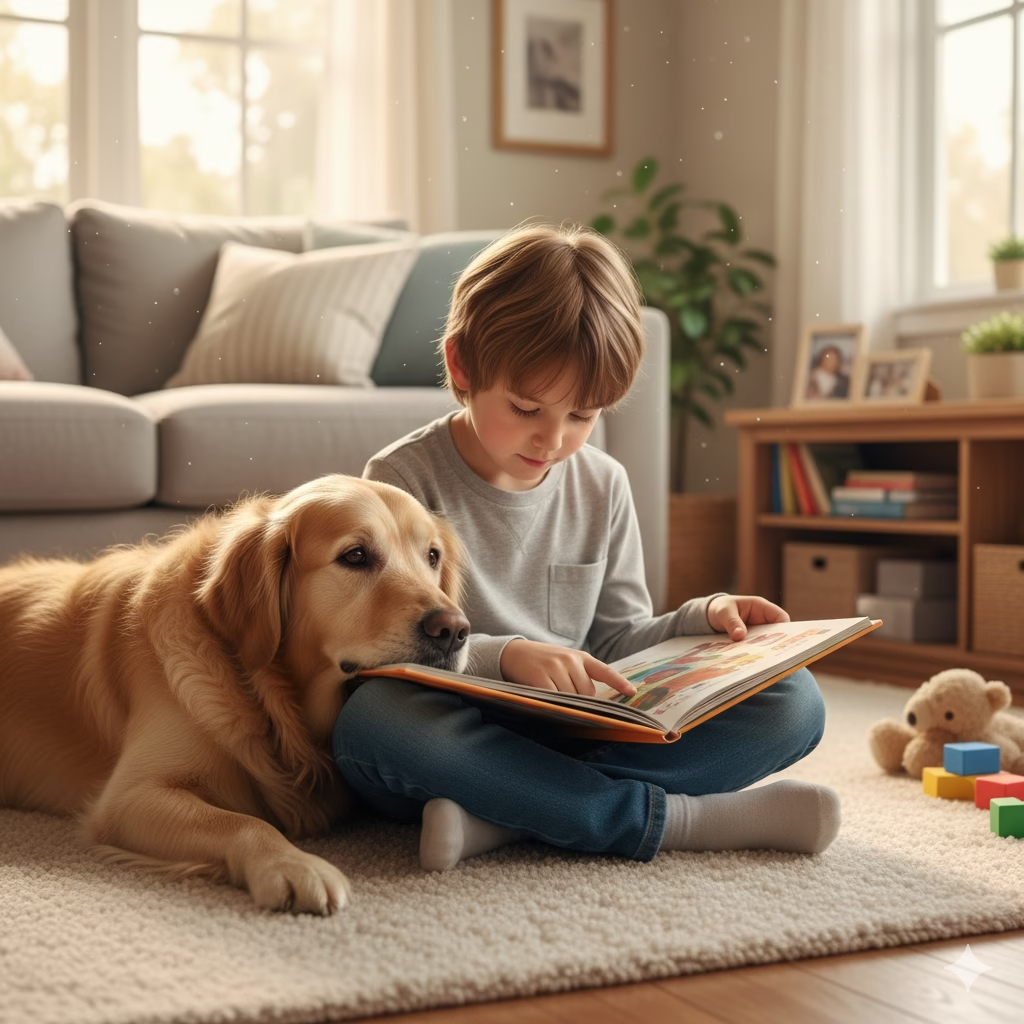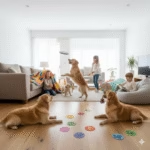The Day the Library Became Less Scary Than the Dog
My son, Liam, was seven, and he was struggling with reading. It wasn’t a question of ability; it was a crisis of confidence. Every time he picked up a book, a little storm cloud of anxiety seemed to gather over his head. He would stumble over a word, flush with embarrassment, and the joy of the story would instantly evaporate, replaced by frustration. Reading aloud, especially to an adult, felt like a performance with a very critical audience. The pressure was turning books into adversaries.
Around the same time, our Golden Retriever, Daisy, was a year old—a calm, gentle soul whose favorite activity was lying like a furry, golden rug in any patch of sunlight she could find. One afternoon, after a particularly tearful reading session, I had an idea born of desperation and instinct. I handed the book back to Liam and said, “Why don’t you try reading it to Daisy? I think she’d really love to hear this story.”
He looked at me skeptically, but then glanced over at Daisy, who was snoozing peacefully. He grabbed the book, curled up beside her on the floor, and began to read in a quiet whisper. I watched, unseen, from the doorway. He stumbled on a word, paused, and then looked at Daisy. She just blinked her big, brown eyes at him and let out a soft sigh. There was no correction. No impatience. No judgment. And in that moment, the storm cloud over Liam’s head vanished. This wasn’t a performance; it was a secret shared between a boy and his dog. This was the day I discovered one of the most powerful, heartwarming, and scientifically-backed secrets of the human-animal bond.
The Science Behind the Snuggles: Why Reading to a Dog Works
What I stumbled upon that day isn’t just a cute anecdote; it’s a practice used by libraries, schools, and literacy programs worldwide. The concept of “reading dogs” is a recognized therapeutic and educational tool, and the psychology behind it is beautifully simple.
The Non-Judgmental Audience
This is the cornerstone of the entire concept. A Golden Retriever is the perfect audience for a struggling reader.
- They Don’t Correct: A dog will never interrupt to say, “That’s not how you pronounce that word.” This removes the fear of making mistakes, which is the single biggest barrier for a reluctant reader.
- They Don’t Judge: A dog doesn’t care about fluency, speed, or perfection. They are simply present, offering silent, unconditional acceptance. This creates a safe space where a child feels free to try, to fail, and to try again without any social penalty.
- They Are Patient: A dog will happily “listen” to the same sentence five times in a row without a hint of frustration. This infinite patience allows a child to work through difficult passages at their own pace.
The Calming Physical Presence
There’s a well-documented physiological reason why this works. The simple act of petting a friendly dog has been shown to lower blood pressure, reduce heart rate, and release oxytocin—the “love hormone”—in the brain. This creates a state of calm and relaxation, which is the optimal neurochemical state for learning. The anxiety that blocks learning pathways is physically reduced by the dog’s presence, opening up the child’s mind to the task at hand.
The Motivation Factor
For many kids, reading can feel like a chore. Reading to the dog reframes the entire activity. It’s no longer a task they have to do for a parent or teacher; it becomes an act of kindness and companionship they get to do for their beloved pet. It gives them a sense of purpose. They aren’t just practicing reading; they are entertaining and comforting their best friend.
How to Create Your Own “Pawsitive Reading” Program at Home
You don’t need a special certification to bring this magic into your own home. With a little intention, you can create a powerful reading ritual for your child and your Golden.
Step 1: Set the Stage for Serenity
Choose the right time and place. This shouldn’t be a spontaneous activity when the house is chaotic. We found the best time was in the late afternoon or just before bed, when the energy of the day was naturally winding down.
- Find a Comfortable Spot: This could be a pile of pillows on the floor, a cozy corner with a beanbag chair, or even your child’s bed. The key is that both child and dog can get comfortable together.
- Minimize Distractions: Turn off the TV. Put phones away. Let this be a quiet, focused time.
- Ensure the Dog is Calm: It’s best to do this after your dog has had a good walk or play session. A tired, relaxed dog is a better listener than one who is bursting with energy.
Step 2: The Invitation (Not the Command)
Frame it as a special activity. Instead of “Go practice your reading,” try, “Daisy looks a little lonely. I bet she would love it if you shared a story with her.” This gives your child a sense of agency and purpose. Let them choose the book they think the dog would most like to “hear.”
Step 3: Define Your Role (The Silent Partner)
Your job as the parent is crucial: you must become almost invisible. Sit nearby, perhaps pretending to read your own book, but do not actively listen or intervene.
- Resist the Urge to Correct: This is the hardest part. If your child mispronounces a word, you must let it go. The dog doesn’t care, and at this moment, neither should you. The goal is fluency and confidence, not perfection.
- Offer Help Only if Asked: If your child gets truly stuck and asks for help, provide it calmly and quickly, then immediately retreat back into your silent role.
- Praise the Act, Not the Performance: When the session is over, don’t say, “You did a great job reading!” Instead, focus on the interaction: “That was so kind of you to read to Daisy. Look how relaxed and happy she is. You are such a good friend to her.”
Step 4: Keep It Short and Sweet
Start with just 5-10 minutes. For a reluctant reader, this is an achievable goal. You want them to end the session feeling successful and proud, not drained. As their confidence grows, they will naturally want to read for longer.
Conclusion: Turning Pages and Building Trust
That first day Liam read to Daisy on the floor, something shifted in him forever. It didn’t magically make him a perfect reader overnight, but it did something far more important: it dismantled his fear. Reading became a secret, quiet joy he shared with his most trusted friend. The dog gave him the courage to find his voice, and in return, he gave her the gift of his companionship.
So, can a dog help a child read? The answer is a resounding, wholehearted yes. They do it not by teaching phonics or grammar, but by teaching something far more fundamental: that it’s safe to be vulnerable, it’s okay to make mistakes, and that a loving, silent presence can be the most powerful teacher of all. By inviting your Golden Retriever to be a part of your child’s literacy journey, you are doing more than just encouraging a skill. You are nurturing empathy, building confidence, and cementing a bond in a way you never thought possible.
A Real-Life Tip: To make the experience even more official and fun, we created a “Dog’s Favorite Books” library card for Daisy. We took an index card, glued a funny picture of her on it, and wrote her name. When Liam finishes reading a book to her, he gets to “stamp” the card. If he particularly enjoyed reading a book and thinks Daisy did too, we add the title to a special list on the back. It turned a simple activity into an official “Library Program for Pups,” and he absolutely loves being the head librarian.

Rafael Souza is a digital marketing strategist and lifelong dog enthusiast. Passionate about Golden Retrievers, he shares practical, research-based tips to help owners provide healthier and happier lives for their furry companions.





